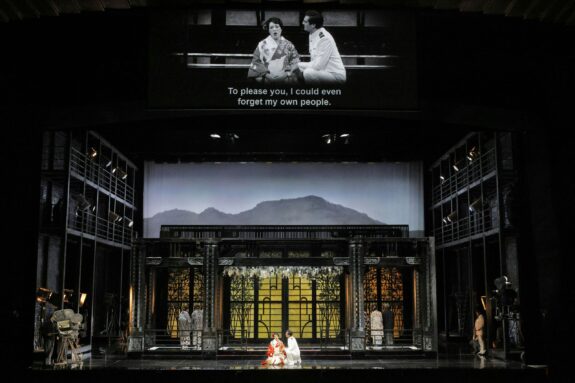 United States Puccini, Madame Butterfly: Soloists, Chorus and Orchestra of LA Opera / James Conlon (conductor). Dorothy Chandler Pavilion, Los Angeles, 21.9.2024. (JRo)
United States Puccini, Madame Butterfly: Soloists, Chorus and Orchestra of LA Opera / James Conlon (conductor). Dorothy Chandler Pavilion, Los Angeles, 21.9.2024. (JRo)

Production:
Director – Mario Gas
Associate Director – Brenna Corner
Sets – Ezio Frigerio
Costumes – Franca Squarciapino
Lighting – Vinicio Cheli
Revival lighting – Pablo Santiago
Chorus director – Jeremy Frank
Cast:
Cio-Cio-San – Karah Son
Pinkerton – Jonathan Tetelman
Suzuki – Hyona Kim
Sharpless – Michael Sumuel
Goro – Rodell Aure Rosel
Bonze – Wei Wu
Kate Pinkerton – Gabrielle Turgeon
Prince Yamadori – Hyungjin Son
Imperial Commissioner – Vinícius Costa
Official Registrar – Ryan Wolfe
In their exquisite interpretation of Puccini’s music, James Conlon and the LA Opera Orchestra were the stars of this Madame Butterfly (aka Madama Butterfly). The production is a misguided affair that at times threatens to derail the Butterfly story, but Conlon drew out the delicate shadings and intense drama of Puccini’s music and kept the action focused.
The Mario Gas production from Madrid’s Teatro Real uses the conceit of a Hollywood movie set in the 1930s where a film of Madame Butterfly is being shot. The rotating set of Butterfly’s house, positioned in the middle of the Dorothy Chandler stage, is meant to simulate a soundstage. People littered the perimeter, including cameramen engaged in shooting the action, which was projected live in black and white on an overhead screen and shared the space with the surtitles. To my mind, the effect diffused the melodrama, jarring the context in which to view the story and destroying the intimacy of a domestic tragedy.

Adding to the confusion is the design of Butterfly’s house. Rather than the simplicity of early twentieth-century Japanese design (the opera was set in 1904 when it premiered at La Scala), the house echoes a 1930’s art deco aesthetic with heavy, dark columns and deco embellishments. This is perplexing since Hollywood in the Golden Age often recreated traditional settings for historical dramas. The only concession to a Japanese house are sliding panels between rooms.
The lighting, so pivotal in the opera, was curiously underwhelming in Act III. Cio-Cio-San’s all-night vigil as she waits for Pinkerton’s arrival is traditionally conveyed in lighting and music. Behind the house, a black and white backdrop of sea and sky was visible. As the vigil progressed through the night and culminated in the sunrise, there was no alteration of light to designate the passage of time. It was the ethereal strains of the Humming Chorus and Puccini’s orchestral music alone that illustrated time’s relentless march to the tragic conclusion.
In keeping with the black-and-white nature of films in the 1930s, the costumes by Franca Squarciapino are in black, white and shades of gray. Only Butterfly’s wedding kimono has touches of color – red flowers against an ivory background.
Jonathan Tetelman, costumed in full-dress naval white, stood out amidst the monochrome. With his high-wattage movie star looks, six-foot-plus frame and ringing tenor, he was a fierce contrast to the petite Karah Son as Cio-Cio-San. Though she could match him in vocal power, the vast difference in their heights added pathos to Pinkerton’s seduction and ultimate abandonment of his innocent fifteen-year-old bride. Their extended love scene in Act I, beginning with ‘Viene la sera’, was entrancing – impassioned singing interspersed with delicate passages of beauty.
Tetelman’s transition from the immature and destructive narcissist of Act I to a mature adult stricken with remorse was palpable in the Act III trio, ‘Lo so che alle sue pene’. Adding to the tragic unfolding was the sumptuous tone and fervent singing of Michael Sumuel, who gave a vivid performance as the compassionate Consul Sharpless. Hyona Kim as Suzuki had the gravitas of the maid who must carry the weight of Butterfly’s tragedy on her sympathetic shoulders. Both in the trio and in the lovely Flower Duet with Son, she sang with lush tone and varying color.
Son’s Butterfly had a fragility that befitted the character, but the production and direction did her a disservice in Act III. Her character is a geisha, and that is integral to the plot. Her father was highborn and ordered by the Emperor to commit ritual suicide. His family fell on hard times and Cio-Cio San became a geisha, highly trained in elegant movement and gracious bearing. Her 1930’s print dress, three-inch heels and contemporary posture made it difficult to imagine this modern woman killing herself with her father’s knife – a prized possession that carried a burden of sorrow and sacrifice with it. Nevertheless, Son persevered to the end, slashing her throat as Pinkerton cried a heart-wrenching ‘Butterfly’.
Additional supporting roles were admirably cast: Rodell Aure Rosel was an appropriately mischievous Goro, the matchmaker; Wei Wu was a steely Bonze, Butterfly’s uncle; and Hyungjin Son made an impressive debut as Prince Yamadori. Four-year-old Enzo Ma was Butterfly’s sweet-faced child and took center stage between James Conlon and Karah Son for final bows to an appreciative audience.
Jane Rosenberg
